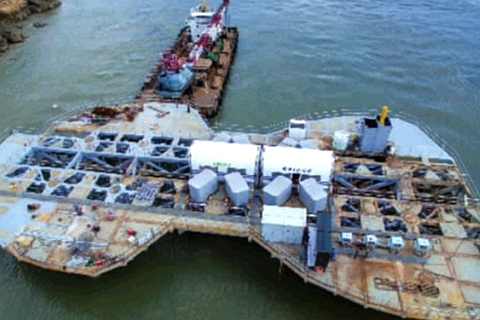By Tom McGregor, CCTV.com Panview commentator and editor
Shenzhen, Xiamen, Shanghai, Tianjin and Qingdao and other cities are dotting the coastlines of southern and eastern China.
The large population densities in the region require a huge energy supply to keep homes and businesses running. But severe pollution could derail the nation's sustainable development mode.
Consequently, Beijing is safeguarding its citizens from further environmental harm by setting in place tougher regulations on heavy polluters and to encourage progress on renewable, otherwise known as green energy.
The key sources of renewable energy in China are wind, solar and hydro power. Chinese companies are also taking a closer look at tidal stream energy, but that is still in its infancy development stage.
What is tidal stream energy?
Tidal stream energy is defined as generating energy by converting the potential energy of the ocean's tides into hydroelectricity, which can be harnessed by a tidal stream generator connected to a tidal barrage.
A tidal stream generator looks similar to a windmill (wind turbine). When the tide flows in and out of the bay, the generator spins underwater to generate power.
The barrage works as a machine to collect and convert tidal energy that can be transferred to a regional power station. Barrages, dam-like structures, are usually placed below bridges.
The tidal barrage is constructed at the mouth of an estuary or bay and allows water to flow through sluice gates amid high-tides and releases water during low tides for turbines to spin.
The tidal stream generator traps energy via water movement.
Dynamic tidal power
Tidal stream generators are reliable, since tides are predictable. Due to the Earth's rotation, moon's movement and gravity, all the ocean's coastlines witness two high tides and two low tides within a 24-hour time-frame.
Marine Current Turbines are relatively cheap and easy to maintain. Yet, the main flaw is the scant power it generates.
A better solution is to develop Dynamic Tidal Power with large barriers that run perpendicular to the coast built out from the shore and an adjoining barrier further out that creates a "T-shaped" pattern.
The barriers block the tides and the water would flow into a series of turbines that are connected next to the dam. Dams should be designed at 30-km. in length, since the longer the dams are, the more electricity it can generate.
Nevertheless, costs to construct dynamic tidal power infrastructure are enormous and would discourage private investments. Nevertheless, China has decided to take a gamble.
Zhejiang greenlights tidal streams
China's Zhejiang Province is located next to the country’s eastern coastline and just south of Shanghai. Zhejiang provincial officials have already supported a series of initiatives to develop an abundant supply of renewable energy.

Tidal stream power station in Zhoushan, Zhejiang Photo from Internet
Local officials have designated the Zhoushan archipelago as the primary site to promote tidal energy projects. Experts believe they can extract 2GW of tidal energy if successful.
Academics at Zhejiang University will lead the pilot project on marine energy. They are collaborating with experts in the United Kingdom, and had visited Bristol, a city recognized as the birthplace of tidal stream energy, in October 2015.
Challenges on costs
Tidal stream energy deserves recognition as a green energy, since it emits no carbon emissions. Nonetheless, the alternative energy source has not reached a commercial stage in China.
Some critics have expressed concerns that pricing remains prohibitive, costing 10 times more than wind energy on the production side. The UK Energy Technologies Institute (ETI) had published a report earlier this year to warn of risks.
"Whilst it has been demonstrated that you can create and capture energy from the sea, it is currently very expensive to do and this has to be addressed for the sector to grow," edie.net quotes, ETI's strategy manager Stuart Bradley, as saying.
Bradley added, "A rethink is required to bring costs down, but the early signs that bodies such as Wave Energy Scotland are tackling this challenge."
ETI suggests the best solutions are to work near inhabited coastlines until grid integration and energy transport are implemented in a more efficient manner.
Zhejiang officials have already followed up on such advice, since the Zhouzhan archipelago project is located near a few medium-sized cities.
Chinese solutions
Costs to construct tidal stream projects and its current inability to produce energy for mass commercial use make the initiative unattractive for investors. And there's no guarantee that after creating models and testing them, the tidal stream energy strategy will succeed after all.
Yet, Beijing and Zhejiang officials believe it's worth the risk to make an attempt and if the project succeeds, they can move forward to deliver more power to residents along China’s coastlines.
Even if the project proves unsatisfactory, China's government and academia, not private investors, will end up absorbing much of the financial losses. So, it's worth a try.
When it comes to the pursuit of innovations, taking risk is essential.Accordingly, China is taking the right steps to explore tidal stream energy by subsidizing projects at the beginning stages.